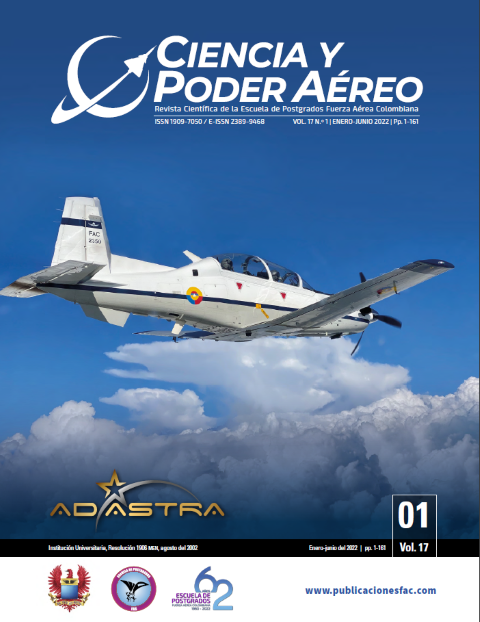Design and construction of a portable system for automatic curing of composite materials
DOI:
https://doi.org/10.18667/cienciaypoderaereo.741Keywords:
vacuum control, curing, composite materials, automatic portable system, heat treatmentAbstract
Air Force (EAF), a leading entity at the national level for aerospace development, constantly seeks to reduce technological dependence for aeronautical maintenance. It is at this point that it becomes necessary to develop all kinds of technological tools that support supervision and maintenance tasks. One of the priority areas for the FAE is composite materials widely used in the manufacture of aeronautical products. For this reason, the design and construction of a portable system for the automatic curing of composite materials is proposed to contribute to the research, characterization, manufacture and repair of aeronautical components. To achieve better mechanical properties required by an aeronautical product in order to withstand the loads to which the material will be subjected during a flight operation, it is essential to achieve good performance in the curing process. For the development of the system, a conceptual methodology was used, proposing various solution alternatives, directing the effort to sketch, size the equipment and choose the best product concept. Once the concept was defined, the system was materialized specifying the vacuum control subsystems that allow a redistribution of the matrix in the reinforcing fibers of the composite material during curing; the heat treatment subsystem is responsible for increasing the temperature of the composite in order to achieve the necessary mechanical properties. The automation of the curing process of composite materials generates optimal results, achieving versatile, useful and robust equipment. Finally, when using the equipment for the purpose for which it was designed, the efficiency of curing composite materials in an automated manner is evident compared to manual curing at room temperature.
Downloads
References
Alzate Rodríguez, E. J., Montes Ocampo, J. W., & Silva Ortega, C. A. (2007). Medición de temperatura: sensores termoeléctricos. Scientia Et Technica, 1(34). https://doi.org/10.22517/23447214.5509
American Society for Testing and Materials (ASTM). (2016). Standard Test Method for Compressive Properties of Polymer Matrix Composite Materials with Unsupported Gage Section by Shear. ASTM D3410/D3410M-03. https://www.astm.org/d3410_d3410m-03.html
American Society for Testing and Materials (astm). (2019). Standard Test Method for Tensile Properties of Polymer Matrix Composite Materials. ASTM D3039/D3039M-08. https://www.astm.org/d3039_d3039m-08.html
American Society for Testing and Materials (ASTM). (2021). Standard Test Methods for Flexural Properties of Unreinforced and Reinforced Plastics and Electrical Insulating Materials. ASTM D790-07. https://www.astm.org/d0790-07.html
Aranburu, A. y Vallejo, F. J. (2019). Desarrollo y automatización de nuevo proceso de fabricación de composites basado en preimpregnados de curado ultravioleta. Materiales Compuestos, 3(3), 21-28. https://revista.aemac.org/materiales-compuestos/article/view/485
Arruti, J. (2016). La técnica de bolsa de vacío en cámara de vacío para la fabricación de materiales compuestos de matriz epoxi. Revista Ingeniería UC, 23(1), 22-29. https://www.redalyc.org/journal/707/70745478004/html/
Cambell F. C.(2004). Manufacturing Processes For Advanced Composites. Elsevier.
Carvajal Dias, A. B. (2020). Caracterización del material compuesto del borde de ataque de la pieza P/N 314-19390-402 del avión A-29 Super Tucano de la Fuerza Aérea Ecuatoriana [trabajo de grado, Universidad de las Fuerzas Armadas]. Repositorio institucional ESPE. http://repositorio.espe.edu.ec/handle/21000/21702
Criollo Calderón, L. G., y Yánez Merchán, P. D. (2019). Modelación computacional y determinación de propiedades mecánicas del perfil alar del avión DA-20-C1 de la Fuerza Aérea Ecuatoriana [trabajo de grado, Universidad de las Fuerzas Armadas]. Repositorio institucional ESPE. http://repositorio.espe.edu.ec/xmlui/handle/21000/21001
Dávila, J. L., Galeas, S. y Guerrero, V. H. (2011). Nuevos materiales: aplicaciones estructurales e industriales. Editorial Escuela Politécnica Nacional.
Herrera Jumbo, L. M. & Vásquez Torres, E. A. (2011). Diseño, programación e instalación de un sistema de control de supervisión y adquisición de datos de un horno lindberg para el laboratorio de tratamientos térmicos [trabajo de grado, Escuela Politécnica Nacional]. Repositorio institucional EPN. https://bibdigital.epn.edu.ec/handle/15000/3993?mode=full
Jimenez O. and Escamilla A. (2008)., “Mejora el proceso de fabricación de elementos estructurales para construcciones en base a arreglos espaciales. REPORTE FINAL,” Queretaro,
Kalpakjian, S. y Steve, S. (2008). Manufactura, ingeniería y tecnología. Pearson Education.
Mezzacasa, R., Segura, M., Irastorza, X., Harismendy, Y. y Sehrschon, H. (2019). Fabricación flexible, eficiente y automatizada de componentes en composite de altas prestaciones. Materiales Compuestos, 3(3), 30-34. https://revista.aemac.org/materiales-compuestos/article/view/486
Mendoza-Nava1 H., Talavera-Ortega M., Estrada-De los Santos F., Mendoza-Facio , Jimenez-Arévalo O. (2014). Caracterización de materiales compuestos reforzados con fibra de carbono fabricados por el método de infusión para aplicaciones aeronáuticas. Revista Avances de Ingeniería Mecánica A.C. UNAM
Miravete, A. (2012). Capítulo I Materias Primas. En A. Miravete, Materiales compuestos. Volumen 1. Editorial Reverté.
Núñez Valle, M. J. y Pantoja Ponce, G. F. (2008). Diseño y construcción de un banco de pruebas para control de vacío (liposuccionador) [trabajo de grado, Escuela Superior Politécnica de Chimborazo]. Repositorio institucional ESPOCH. http://dspace.espoch.edu.ec/bitstream/123456789/1688/1/15T00396.pdf
Downloads
Published
Issue
Section
License
Copyright (c) 2022 Escuela de Postgrados de la Fuerza Aérea Colombiana

This work is licensed under a Creative Commons Attribution 4.0 International License.
Assignment of Copyrights
Authors assign Ciencia y Poder Aéreo journal the exclusive rights (reproduction, distribution, public communication, and transformation) to exploit and commercialize their work, in whole or in part, in all the formats and modalities of present or future exploitation, in all languages, throughout the life of the work and throughout the world.
All contents published in Ciencia y Poder Aéreo journal are licensed under a Creative Commons Attribution 4.0 International License, whose complete information is available at http://creativecommons.org/licenses/by/4.0/
Under the terms of this license, users are free to download, print, extract, archive, distribute and publicly communicate the content of articles, provided that proper credit is granted to authors and Ciencia y Poder Aéreo, scientific journal of the Graduate School of the Colombian Air Force. Except when otherwise indicated, this site and its contents are licensed under a Creative Commons Attribution 4.0 International License.
For other uses not considered under this license it is required to contact the Director or the Editor of the journal at the e-mail address cienciaypoderaereo1@gmail.com.
The Graduate School of the Colombian Air Force and this publication are not responsible for the concepts expressed in the articles, including the metadata or the affiliation stated by authors. This is the full responsibility of the authors.






















